Ap biology unit 2 - Study guides, Class notes & Summaries
Looking for the best study guides, study notes and summaries about Ap biology unit 2? On this page you'll find 154 study documents about Ap biology unit 2.
Page 4 out of 154 results
Sort by

-
AP Biology Unit 2 Test Questions and Answers | 100% Pass
- Exam (elaborations) • 6 pages • 2024
- Available in package deal
-
- $9.99
- + learn more
AP Biology Unit 2 Test Questions and Answers | 100% Pass 2 organelles that contain their own DNA separate from the chromosome - Answer️️ - Mitochondria and chloroplast What domains fall under prokaryotic cells? - Answer️️ -Bacteria and archaea What are the basic features of all cells? - Answer️️ -Membrane, cytoplasm, chromosomes, ribosomes This organelle synthesizes lipids, metabolizes carbohydrates, detoxifies poison, and stores calcium - Answer️️ -Smooth ER This cell i...
AP Biology Unit 2 Test questions and (correct) answers latest review
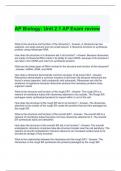
-
AP Biology Unit 2.1 AP Exam review 2024 Questions with correct Answers
- Exam (elaborations) • 3 pages • 2024
- Available in package deal
-
- $8.99
- + learn more
AP Biology Unit 2.1 AP Exam review
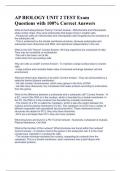
-
AP BIOLOGY UNIT 2 TEST Exam Questions with 100% Correct Answers
- Exam (elaborations) • 9 pages • 2023
- Available in package deal
-
- $11.99
- + learn more
What is the Endosymbiosis Theory? Correct Answer - Mitochondria and Chloroplasts share similar origin, they were prokaryotes that began living in smaller cells. - Prokaryotic cells (w/ mitochondria and chloroplasts) were engulfed by the ancestors of the eukaryotic cell. - This is evidenced by the double membrane structure, because prokaryotes and eukaryotes have ribosomes and DNA, and reproduce independently in the cell. What is the Cell Theory? Correct Answer -All living organisms are com...
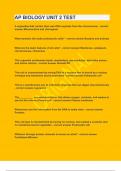
-
AP BIOLOGY UNIT 2 TEST|UPDATED&VERIFIED|GUARANTEED SUCCESS
- Exam (elaborations) • 6 pages • 2023
- Available in package deal
-
- $15.49
- + learn more
2 organelles that contain their own DNA separate from the chromosome Mitochondria and chloroplast What domains fall under prokaryotic cells? Bacteria and archaea What are the basic features of all cells? Membrane, cytoplasm, chromosomes, ribosomes This organelle synthesizes lipids, metabolizes carbohydrates, detoxifies poison, and stores calcium Smooth ER This cell is characterized by having DNA in a nucleus that is bound by a nuclear envelope and membrane bound o...
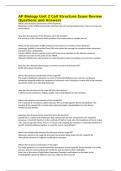
-
AP Biology Unit 2 Cell Structure Exam Review Questions and Answers
- Exam (elaborations) • 14 pages • 2024
- Available in package deal
-
- $10.39
- + learn more
AP Biology Unit 2 Cell Structure Exam Review Questions and Answers What is the structure and function of the ribosome? Ribosomes consist of RNA and proteins and they help with synthesizing proteins. There is a large and small subunit. How does the structure of the ribosome aid in the function? The structure of the ribosome allows proteins to be made inside or outside the cell. What are the three types of RNA involved in the structure or function of the ribosome? messenger (mRNA) is...
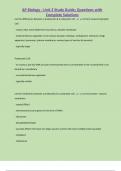
-
AP Biology - Unit 2 Study Guide; Questions with Complete Solutions
- Exam (elaborations) • 16 pages • 2024
- Available in package deal
-
- $12.99
- + learn more
AP Biology - Unit 2 Study Guide; Questions with Complete Solutions List the differences between a prokaryotic & a eukaryotic cell. Correct answer-Eukaryotic Cell: - nucleus (has more DNA) that's bound by a double membrane - endomembrane organelles in the cytosol (nuclear envelope, endoplasmic reticulum, Golgi apparatus, lysosomes, plasma membrane, various types of vesicles & vacuoles) - typically larger Prokaryotic Cell: - no nucleus, but has DNA (circular chromosome) that is concen...
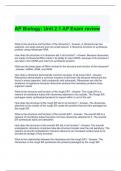
-
AP Biology Unit 2.1 AP Exam review Questions with correct Answers
- Exam (elaborations) • 3 pages • 2024
- Available in package deal
-
- $10.49
- + learn more
AP Biology Unit 2.1 AP Exam review
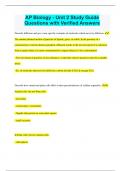
-
AP Biology - Unit 2 Study Guide Questions with Verified Answers
- Exam (elaborations) • 18 pages • 2024
- Available in package deal
-
- $9.99
- + learn more
AP Biology - Unit 2 Study Guide Questions with Verified Answers Describe diffusion and give some specific examples of molecules which move by diffusion. - The random thermal motion of particles of liquids, gases, or solids. In the presence of a concentration or electrochemical gradient, diffusion results in the net movement of a substance from a region where it is more concentrated to a region where it is less concentrated. - The movement of particles of any substance, so that they tend ...
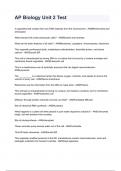
-
AP Biology Unit 2 Test questions and answers guaranteed pass 2024/2025
- Exam (elaborations) • 4 pages • 2024
- Available in package deal
-
- $9.99
- + learn more
AP Biology Unit 2 Test questions and answers guaranteed pass 2024/2025

That summary you just bought made someone very happy. Also get paid weekly? Sell your study resources on Stuvia! Discover all about earning on Stuvia



